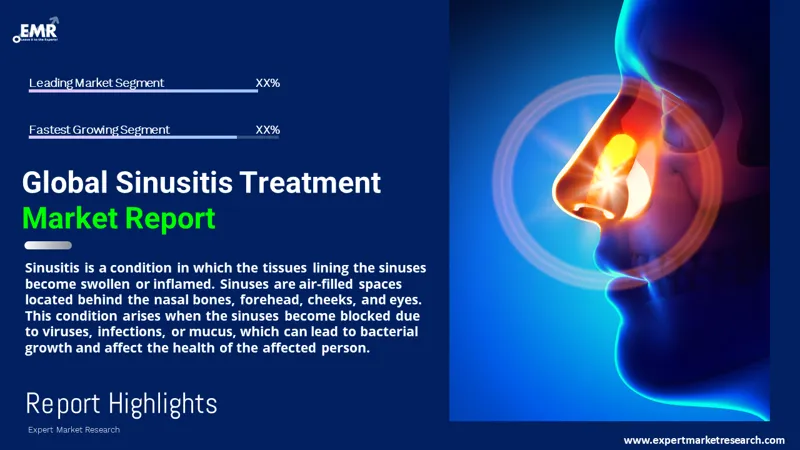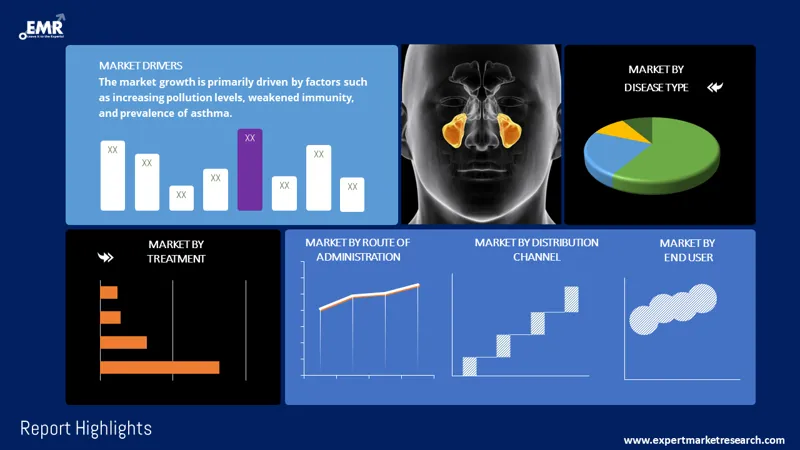
Consumer Insights
Uncover trends and behaviors shaping consumer choices today
Procurement Insights
Optimize your sourcing strategy with key market data
Industry Stats
Stay ahead with the latest trends and market analysis.
The global sinusitis treatment market size reached a value of about USD 3.45 Billion in 2025. The market is expected to grow at a CAGR of 3.80% during the forecast period of 2026-2035 to attain a value of USD 5.01 Billion by 2035, driven by the rising prevalence of increasing pollution and increasing nasal infections among people worldwide.
Base Year
Historical Period
Forecast Period
Compound Annual Growth Rate
3.8%
Value in USD Billion
2026-2035
*this image is indicative*
When the tissues lining the sinuses gets swollen or inflamed, the condition is called sinusitis. Sinuses are the spaces in the skull that are filled with air. Sinuses can be found behind the nasal bones, forehead, cheeks, and eyes. The problem occurs when these sinuses get blocked due to any reason such as viruses, infections, or mucus. This condition allows the growth of bacteria in sinuses and impact the health of a person suffering from sinusitis. Healthy sinuses have no viruses or germs.

Read more about this report - REQUEST FREE SAMPLE COPY IN PDF
Sinusitis may develop due to the conditions that are mentioned below:
Sinusitis is a condition which comes with the underlying symptoms. These symptoms are divided into two separate categories as major and minor symptoms. Major symptoms include lack of smelling senses, pressure in the face usually and especially while bending downward or forward, pressure in ear and headaches, having a stuffed or blocked nose and minor symptoms include coughing, exhaustion, fever, bad breath, pain in teeth.
Sinusitis can be divided into three categories:
Sinusitis can be cured without medicines and it is not always preferred to have a medicated supervision when having sinusitis. Most of the sinusitis does not require exclusive treatment. Usually, it lasts for a week to a couple of weeks.
Keeping strict track on your hygiene and your surroundings is often useful if it is recurring. Using humidifiers is also a great way to keep the air around you humid. Taking steam is also often helpful in sinusitis. These steamers could be home-made or market bought dedicated steam developers. This process of inhaling steam vapours can help ease the blocked nose and enable it to breathe again, without many efforts. A hot towel treatment could also be used to reduce the face pressure caused by sinusitis. Using a towel and dipping it into warm water and then putting it on the face can ease the face pressure developed due to sinusitis.

Read more about this report - REQUEST FREE SAMPLE COPY IN PDF
According to the market research report the market segment can be categorized into following segments:
Market Breakup by Disease Treatment
Market Breakup by Disease Type
Market Breakup by Route of Administration
Market breakup by Distribution Channel
Market breakup by End User
Market Breakup by Region
United States is among the leading regions as it has a high number of sinusitis patients. People suffering for nasal blockages or allergies related to skin or people with asthma and weakened immune systems are at the highest risk of getting and developing sinusitis.
People living in places where the transport movement is higher has are also at major risks as the pollutants present in pollution outside are potentially lethal and can cause numerous diseases and disorders related to breathing and lungs, nose. Changing and unhealthy lifestyle is also a major driver for the rise in prevalence of sinusitis globally.
Sinusitis generally does not need to be treated as it goes away on its own. In case the conditions start to go out control, they can be diagnosed by the help of several methods. This will probably happen if the person is having chronic sinusitis. Only after diagnosing, the doctor proceeds further for the treatment of sinusitis. The methods by which sinusitis can be diagnosed are as follows:
As sinusitis does not need to be treated in most cases, these treatments are for the people who are suffering from chronic sinusitis. There are several treatments that are provided by doctors to treat sinusitis, depending on the requirement of the patients existing condition.
Common treatments of sinusitis are as follows:
The market is growing and is expected to grow in coming years as well. The rise in the market is due to various factors, one of which is the exponentially growing pollution globally. Due to the increasing pollution, people are developing sinusitis who have no history with any nasal infections. Acute sinusitis is the most common form of sinusitis affecting people worldwide. Due to the increasing pollution and hectic lifestyles, people usually ignore the common signs of sinus that are similar to having a cold like symptoms. Around 90% of patients having cold, generally have viral sinusitis components. The most common causes of viral sinusitis include polluted air, dust, irritants, viruses, smoke, and bacteria.
People with sinusitis are likely to develop other diseases related to breathing as well. Asthma and sinusitis are the conditions that usually exists simultaneously in a patient and are most common. The factors are harmful pollutants that may develop more dangerous conditions which could last for a lifetime.
North America contributes to the largest market share of market size due to the high prevalence of increasing pollution, weakened immune system, and increasing nasal inflammation disorders.
The report gives an in-depth analysis of the key players involved in the sinusitis treatment market, sponsors manufacturing the drugs, and putting them through trials to get FDA approvals. The companies included in the market are as follows:




*While we strive to always give you current and accurate information, the numbers depicted on the website are indicative and may differ from the actual numbers in the main report. At Expert Market Research, we aim to bring you the latest insights and trends in the market. Using our analyses and forecasts, stakeholders can understand the market dynamics, navigate challenges, and capitalize on opportunities to make data-driven strategic decisions.*
Get in touch with us for a customized solution tailored to your unique requirements and save upto 35%!
The treatment market attained a value of USD 3.45 Billion in 2025, driven by the rising air pollution.
The sinusitis treatment market is likely to grow at a CAGR of 3.80% during the forecast period of 2026-2035 to attain a value of USD 5.01 Billion by 2035.
The major drivers for the market growth include rising pollution, reduced immunity, and asthma.
The treatment methods include analgesics, antihistamines, corticosteroids, antibiotics, sulphonamides, quinolones, and surgery, among others.
Hospitals, home-cares, and specialty clinics, among others are the segments of global sinusitis treatment market.
Market breakup by route of administration is topical, oral, nasal, and injectable.
The major regional markets are North America, Europe, Asia Pacific, Latin America, Middle East and Africa.
The key players in the sinusitis treatment market involves Pfizer Inc., Merck KGaA, Sanofi, Biocare Medical LLC, Teva Pharmaceutical Industries, Bristol-Myers Squibb Company, GSK plc, Bayer AG, AstraZeneca, Regeneron Pharmaceuticals Inc., and OptiNose US Inc., among others.
Explore our key highlights of the report and gain a concise overview of key findings, trends, and actionable insights that will empower your strategic decisions.
| REPORT FEATURES | DETAILS |
| Base Year | 2025 |
| Historical Period | 2019-2025 |
| Forecast Period | 2026-2035 |
| Scope of the Report |
Historical and Forecast Trends, Industry Drivers and Constraints, Historical and Forecast Market Analysis by Segment:
|
| Breakup by Treatment |
|
| Breakup by Disease Type |
|
| Breakup by Route of Administration |
|
| Breakup by End User |
|
| Breakup by Distribution Channel |
|
| Breakup by Region |
|
| Market Dynamics |
|
| Supplier Landscape |
|
| Companies Covered |
|
Datasheet
One User
USD 3,299
USD 2,969
tax inclusive*
Single User License
One User
USD 5,499
USD 4,949
tax inclusive*
Five User License
Five User
USD 6,999
USD 5,949
tax inclusive*
Corporate License
Unlimited Users
USD 8,199
USD 6,969
tax inclusive*
*Please note that the prices mentioned below are starting prices for each bundle type. Kindly contact our team for further details.*
Flash Bundle
Small Business Bundle
Growth Bundle
Enterprise Bundle
*Please note that the prices mentioned below are starting prices for each bundle type. Kindly contact our team for further details.*
Flash Bundle
Number of Reports: 3
20%
tax inclusive*
Small Business Bundle
Number of Reports: 5
25%
tax inclusive*
Growth Bundle
Number of Reports: 8
30%
tax inclusive*
Enterprise Bundle
Number of Reports: 10
35%
tax inclusive*
How To Order

Select License Type
Choose the right license for your needs and access rights.

Click on ‘Buy Now’
Add the report to your cart with one click and proceed to register.

Select Mode of Payment
Choose a payment option for a secure checkout. You will be redirected accordingly.
Gain insights to stay ahead and seize opportunities.

Get insights & trends for a competitive edge.

Track prices with detailed trend reports.

Analyse trade data for supply chain insights.

Leverage cost reports for smart savings

Enhance supply chain with partnerships.

Connect For More Information
Our expert team of analysts will offer full support and resolve any queries regarding the report, before and after the purchase.
Our expert team of analysts will offer full support and resolve any queries regarding the report, before and after the purchase.
We employ meticulous research methods, blending advanced analytics and expert insights to deliver accurate, actionable industry intelligence, staying ahead of competitors.
Our skilled analysts offer unparalleled competitive advantage with detailed insights on current and emerging markets, ensuring your strategic edge.
We offer an in-depth yet simplified presentation of industry insights and analysis to meet your specific requirements effectively.
Share